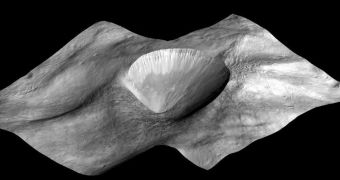A series of unusual surface features were recently discovered on the giant asteroid Vesta. Some of them were never before seen on a space rock, while others are very rare and, therefore, interesting to study. The images were collected by the NASA Dawn spacecraft.
The details the orbiter saw came unexpectedly for the research team. Scientists pieced together numerous images of the asteroid's surface, taken from a variety of angles, which enabled them to produce highly-detailed datasets of the object.
Undoubtedly, these data will soon be used by various research teams to conduct studies of the protoplanet. Vesta is believed to have had the potential to turn into a rocky planet once. However, something interfered with its growth process, and researchers want to figure out what that was.
Details of the new photo gallery were discussed yesterday, March 21, by experts attending the Lunar and Planetary Science Conference, in The Woodlands, Texas. One of the most important discoveries was that some areas on the asteroid's surface were twice as bright as others.
This gives Vesta some interesting properties, such as for example the fact that it's the only object in the Inner Asteroid Belt (IAB) to be visible in the night sky with the naked eye. The IAB lies between the orbits of Mars and Jupiter.
“Our analysis finds this bright material originates from Vesta and has undergone little change since the formation of Vesta over 4 billion years ago,” University of Maryland in College Park (UM) Dawn participating scientist, Jian-Yang Li, explains.
“We're eager to learn more about what minerals make up this material and how the present Vesta surface came to be,” the expert goes on to say. Li adds that most of the bright areas on the asteroid are located in and around craters.
It could be that the bright material lies underneath Vesta's surface, and that it was exposed by impacts. A mixing process may have also occurred, which combined the darker material on the asteroid with the brighter one under the surface.
But these are all speculations at this point. Researchers have yet to establish precisely what is going on at the solar system's largest asteroid.
“One of the surprises was the dark material is not randomly distributed. This suggests underlying geology determines where it occurs,” Arizona State University (ASU) Dawn participating scientist David Williams says.

 14 DAY TRIAL //
14 DAY TRIAL //